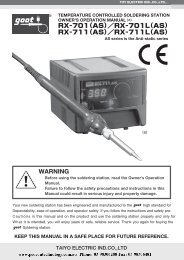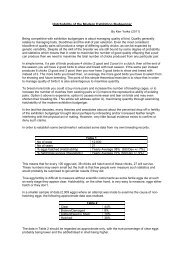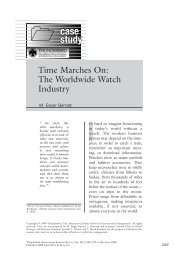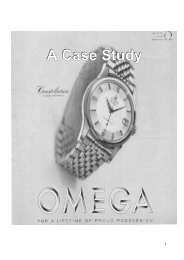Thanks
Thanks
Thanks
Create successful ePaper yourself
Turn your PDF publications into a flip-book with our unique Google optimized e-Paper software.
Deviations in an unadjusted movement in various positions and in various temperatures could be as much, or<br />
more, than 30 seconds a day. The role of the Omega production regleurs (master watchmakers) was to<br />
observe and test for deviations and make the adjustments to meet Omega’s criteria of attaining “especially<br />
good results” from the testing bureaux. Some of the procedures undertaken to improve accuracy included<br />
testing and correcting for trueness, or true-ishness, of the balance (Perfect roundness of the balance and<br />
exact pivot centring): poising to eliminate centre of gravity error; tiny manipulations of the micro regulator to<br />
keep the number of swings of the balance as constant as possible, and a variety of other procedures to ensure<br />
each piece exceeded chronometre standards.<br />
Some of the work in adjustment was automated or at least carried out electronically as the advertisement<br />
overleaf demonstrates. When one discounts the hyperbole, what the advertisement also illustrates is that with<br />
25% of its workforce devoted to quality control, the company recognised the absolute necessity in the 1960s of<br />
ensuring that the Omega Constellation lived up fully to claims of quality and precision made in advertising.<br />
Slow Beat – High Dependability<br />
The mid 500 series was a slow-beat<br />
movement with the balance wheel oscillating<br />
at 19,800 half swings an hour, although a socalled<br />
‘true’ slow-beat is said to oscillate at<br />
18,000 half swings an hour. It’s a useful<br />
digression to evaluate the comparative<br />
benefits of slow beat over fast beat<br />
movements. Slow-beat movements, in<br />
general, require less energy (torque) to drive<br />
them and therefore can accommodate softer<br />
and thinner mainsprings.<br />
Having less power under the bonnet - even<br />
after compensating for energy loss through<br />
the drive train and escapement - means a<br />
corresponding reduction in stress and strain,<br />
reducing friction levels through the train to the<br />
escapement. It also allows for less friction on<br />
the winding system. By extension, a quality<br />
watch that endures less friction is likely to<br />
require fewer visits to the workshop for repair<br />
and have far fewer worn parts in need of<br />
replacement. Further, it can be argued that a<br />
quality slow-beat movement will not wear as<br />
much as a fast beat movement if lubrication<br />
failure occurs, as it often does in the<br />
everyday world.<br />
Combine lower friction and less potential<br />
wear - caused by irregular or incorrect<br />
servicing - with a first-rate escapement,<br />
micrometer regulation and a movement that<br />
had a high level of ‘functional finish’<br />
(polishing and finishing of intermeshing parts<br />
of the movement where friction and wear occur) and you may begin to understand why the mid-500 series<br />
earned such a spectacular reputation, initially for precision and later for longevity.<br />
© Desmond Guilfoyle. Diagrams and photographs not owned by the author retain the copyright of their owners 14
















